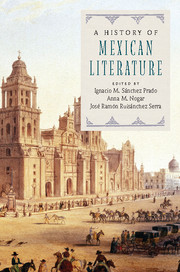Book contents
- Frontmatter
- Contents
- List of contributors
- Introduction
- PART I COLONIAL LITERATURE
- PART II THE NINETEENTH CENTURY
- PART III TWENTIETH AND TWENTY-FIRST CENTURIES
- 15 The Ateneo de la Juventud: The Foundations of Mexican Intellectual Culture
- 16 Regimes of the Avant-garde: Colonialists, Stridentists, Proletarians, Surrealists, Contemporáneos, and Independent Rupture (1920–1950)
- 17 The Institution of Fiction: From Yáñez, Rulfo, and Fuentes to Pitol and Del Paso
- 18 Octavio Paz: Literature, Modernity, Institutions
- 19 Mexican Poetry after the Avant-garde
- 20 Nonfictions: Essay, Criticism, and Chronicle
- 21 Balancing Acts: Twentieth- and Twenty-First-Century Mexican Theater
- 22 Women Writers in the Land of “Virile” Literature
- 23 The Hidden Histories of Gender: LGBTQ Writers and Subjectivities in Mexico
- 24 Mexican Literature in the Neoliberal Era
- PART IV MEXICAN LITERATURE BEYOND BOUNDARIES
- Index
- References
23 - The Hidden Histories of Gender: LGBTQ Writers and Subjectivities in Mexico
from PART III - TWENTIETH AND TWENTY-FIRST CENTURIES
Published online by Cambridge University Press: 05 July 2016
- Frontmatter
- Contents
- List of contributors
- Introduction
- PART I COLONIAL LITERATURE
- PART II THE NINETEENTH CENTURY
- PART III TWENTIETH AND TWENTY-FIRST CENTURIES
- 15 The Ateneo de la Juventud: The Foundations of Mexican Intellectual Culture
- 16 Regimes of the Avant-garde: Colonialists, Stridentists, Proletarians, Surrealists, Contemporáneos, and Independent Rupture (1920–1950)
- 17 The Institution of Fiction: From Yáñez, Rulfo, and Fuentes to Pitol and Del Paso
- 18 Octavio Paz: Literature, Modernity, Institutions
- 19 Mexican Poetry after the Avant-garde
- 20 Nonfictions: Essay, Criticism, and Chronicle
- 21 Balancing Acts: Twentieth- and Twenty-First-Century Mexican Theater
- 22 Women Writers in the Land of “Virile” Literature
- 23 The Hidden Histories of Gender: LGBTQ Writers and Subjectivities in Mexico
- 24 Mexican Literature in the Neoliberal Era
- PART IV MEXICAN LITERATURE BEYOND BOUNDARIES
- Index
- References
Summary
Spanish conquistadors and missionaries who disembarked in a previously unknown world soon baptized as New Spain were the first to record evidence of male homosexuality in Mexico. In chapter CCVIII of his True History of the Conquest of New Spain (written before 1568, published in 1632), upon observing pagan rites practiced by members of the local population, which included both human sacrifice and anthropophagy, foot soldier chronicler Bernal Díaz del Castillo proclaims that in addition to such atrocities, “these people were all sodomites, especially those who lived in the coastal regions and warm climes; to such a degree that the boys wandered around dressed like women, working in that most diabolical and abominable profession” (1992: 713). During the siege of México-Tenochtitlan, Díaz del Castillo also noted the way in which Mexica warriors employed the offensive Nahuatl term cuiloni (sodomite = coward) as a verbal offense hurled at Spanish soldiers while the latter were being forced to retreat from the capital during what is known as the Noche Triste, or Sad Night.
However, the first individual credited for undertaking a quasi-ethnographic study of postconquest Nahuas was Franciscan missionary Bernardino de Sahagún (1499–1590), who arrived to New Spain's capital in 1529. By means of observation and interviews, he studied the local indigenous population for over fifty years, a fruitful period in which he gathered information for an illustrated Nahuatl–Spanish dictionary later included in his General History of the Things of New Spain, also known as the Florentine Codex (completed in 1569). Throughout this extended period, Sahagún evidently encountered more than a few references to (male) homosexuality, for in Book X of his History, he dedicates a small section of a chapter concerning the “Virtues and Vices of These Indians” to “Depraved Individuals.” There the Franciscan laconically states that:
[the] sodomite is abominable, nefarious and detestable, worthy of ridicule and snide remarks. The stench and ugliness of his despicable sin is insufferable due to the disgust it provokes in men. In every way the homosexual shows himself as effeminate and womanlike, in his gait and in his speech. Due to such considerations, he deserves to be burned … (1981: 99)
Moreover, Sahagún is credited with coining a phrase used to describe the sodomites’ greatest offense: el pecado nefando – the despicable sin.
- Type
- Chapter
- Information
- A History of Mexican Literature , pp. 350 - 364Publisher: Cambridge University PressPrint publication year: 2016



